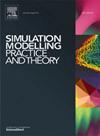Topology Rewiring Strategies to construct robust scale-free medical Internet of Things Networks
IF 3.5
2区 计算机科学
Q2 COMPUTER SCIENCE, INTERDISCIPLINARY APPLICATIONS
引用次数: 0
Abstract
The Internet of Things (IoT) network topologies are now most commonly impacted by cyberattacks. The scale-free network topologies have demonstrated great robustness against random attacks by preserving the connectedness of the nodes. The scale-free network topologies’ susceptibility to malicious attacks, however, is a significant worry. It is due to the significance of the scale-free networks in different fields of life like medical, transportation, education, agriculture, etc. Also, high-degree node removal diminishes the network’s resiliency and compromises the connection of the majority of nodes. In this study, we offer several rewiring techniques for building scale-free, reliable Medical Internet of Things (MIoT) networks that can withstand malicious attacks. Initially, the scale-free MIoT network’s performance optimization is ensured using a heuristic algorithm known as the Great Deluge Algorithm (GDA). Then, four rewiring strategies are formulated. The initial approach is degree dissortativity, which rewires the network if all nodes have high maximum connectivity to other neighbors with a similar degree. For the second strategy, we introduced a degree difference operation based on degree dissortativity to ensure that the edges that are connected possess low dissortativity and degree difference. Meanwhile, the remaining two strategies take into account the node load bound and enhanced GDA to increase network robustness. The performance of the proposed rewiring strategies is validated through simulations. The results prove that the proposed strategies increase network robustness by up to 25% compared to Hill Climbing (HC) and Simulated Annealing (SA). Additionally, the strategies show great success in improving network connectivity and graph density. However, their computational time is higher compared to HC and SA.
构建鲁棒无标度医疗物联网的拓扑重布线策略
物联网(IoT)网络拓扑结构现在最常受到网络攻击的影响。无标度网络拓扑通过保持节点的连通性,对随机攻击具有很强的鲁棒性。然而,无标度网络拓扑对恶意攻击的易感性是一个重大的担忧。这是由于无标度网络在医疗、交通、教育、农业等不同生活领域的重要性。此外,高度节点移除会降低网络的弹性,并危及大多数节点的连接。在本研究中,我们提供了几种重新布线技术,用于构建可承受恶意攻击的无标度、可靠的医疗物联网(MIoT)网络。最初,使用一种称为大洪水算法(GDA)的启发式算法来确保无标度的MIoT网络的性能优化。然后,制定了四种重新布线策略。最初的方法是度分解,如果所有节点与其他具有相似度的邻居具有较高的最大连通性,则重新连接网络。对于第二种策略,我们引入了基于度散度的度差操作,以确保连接的边具有低散度和度差。同时,其余两种策略考虑了节点负载绑定和增强的GDA来提高网络的鲁棒性。通过仿真验证了所提重布线策略的性能。结果证明,与爬山(HC)和模拟退火(SA)相比,所提出的策略将网络的鲁棒性提高了25%。此外,这些策略在改善网络连通性和图密度方面取得了巨大成功。但是,与HC和SA相比,它们的计算时间更高。
本文章由计算机程序翻译,如有差异,请以英文原文为准。
求助全文
约1分钟内获得全文
求助全文
来源期刊

Simulation Modelling Practice and Theory
工程技术-计算机:跨学科应用
CiteScore
9.80
自引率
4.80%
发文量
142
审稿时长
21 days
期刊介绍:
The journal Simulation Modelling Practice and Theory provides a forum for original, high-quality papers dealing with any aspect of systems simulation and modelling.
The journal aims at being a reference and a powerful tool to all those professionally active and/or interested in the methods and applications of simulation. Submitted papers will be peer reviewed and must significantly contribute to modelling and simulation in general or use modelling and simulation in application areas.
Paper submission is solicited on:
• theoretical aspects of modelling and simulation including formal modelling, model-checking, random number generators, sensitivity analysis, variance reduction techniques, experimental design, meta-modelling, methods and algorithms for validation and verification, selection and comparison procedures etc.;
• methodology and application of modelling and simulation in any area, including computer systems, networks, real-time and embedded systems, mobile and intelligent agents, manufacturing and transportation systems, management, engineering, biomedical engineering, economics, ecology and environment, education, transaction handling, etc.;
• simulation languages and environments including those, specific to distributed computing, grid computing, high performance computers or computer networks, etc.;
• distributed and real-time simulation, simulation interoperability;
• tools for high performance computing simulation, including dedicated architectures and parallel computing.
 求助内容:
求助内容: 应助结果提醒方式:
应助结果提醒方式:


